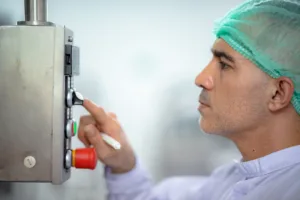
Indoor vertical farming is becoming an increasingly popular and sustainable method for growing fresh produce in urban environments. These controlled environments rely heavily on electrical systems to maintain optimal conditions for plant growth. However, these systems can also present safety hazards if not properly managed. In this blog post, we’ll discuss the importance of lockout equipment in electrical systems within an indoor vertical farm to ensure that people don’t get hurt.
- Understanding the Hazards
Electrical systems in an indoor vertical farm can present various risks, including electrocution, electrical fires, and arc flash incidents. These hazards can arise from improper installation, faulty equipment, or inadequate maintenance. Lockout equipment is essential in minimizing these risks and ensuring the safety of workers and visitors.
- The Role of Lockout Equipment
Lockout equipment is a safety procedure used to prevent the accidental release of hazardous energy during maintenance, repair, or inspection activities. The equipment is designed to isolate and secure energy sources, preventing them from being accidentally turned on or off. In an indoor vertical farm, this equipment is crucial to protect workers from dangerous electrical hazards.
- Types of Lockout Equipment for Electrical Systems
There are several types of lockout equipment specifically designed for electrical systems, including:
a. Circuit Breaker Lockouts: These lockout devices are designed to fit over a circuit breaker switch, preventing it from being turned on or off. They can be used for single or multi-pole circuit breakers.
b. Plug Lockouts: Plug lockouts are used to secure electrical plugs, ensuring that equipment remains disconnected during maintenance or repair work.
c. Wall Switch Lockouts: These lockouts are designed to cover wall switches, preventing them from being accidentally turned on or off.
d. Group Lockout Boxes: Group lockout boxes are used to store and secure multiple lockout devices during group maintenance activities, ensuring that all energy sources are isolated and locked out.
- Implementing Lockout/Tagout (LOTO) Procedures
To ensure the effective use of lockout equipment in an indoor vertical farm, a comprehensive Lockout/Tagout (LOTO) program should be implemented. This program should include:
a. Proper employee training on the use of lockout equipment and LOTO procedures.
b. Clear and standardized procedures for locking out and tagging out energy sources during maintenance or repair activities.
c. Regular inspection and maintenance of lockout equipment.
d. Communication and coordination among all employees and contractors to ensure everyone is aware of ongoing LOTO activities.
- Benefits of Lockout Equipment and LOTO Procedures
Implementing lockout equipment and LOTO procedures in an indoor vertical farm can yield several benefits, including:
a. Improved worker safety by preventing accidents and injuries related to electrical hazards.
b. Reduced downtime and equipment damage resulting from accidents or electrical incidents.
c. Compliance with local and national safety regulations, minimizing potential fines or legal actions.
d. Enhanced overall safety culture, promoting a responsible and proactive approach to workplace safety.
Conclusion
Lockout equipment is a critical component in ensuring the safety of electrical systems within an indoor vertical farm. By implementing proper lockout procedures and equipment, you can protect workers from the dangers of electrical hazards, reduce downtime, and create a safer working environment for everyone involved. It’s essential to invest in quality lockout equipment and provide thorough training to all employees to make your indoor vertical farm a safe and productive space.
